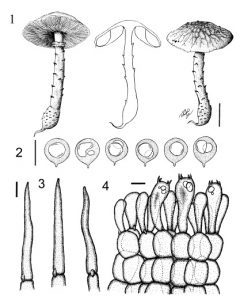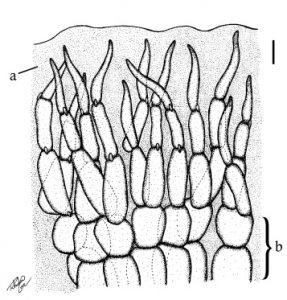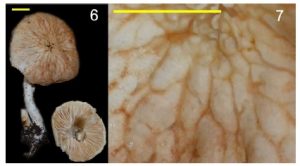Limacella brunneovenosa C.C. Nascimento & Wartchow, sp. nov. Index Fungorum number: IF 819451
Etymology: From Latim: ‘brunneo’ (= brown) and ‘venosa’ (= veins); referring to the brownish veins embossing the pileus surface of the new species.
Type: Brazil, Paraíba, Cabedelo, Floresta Nacional Restinga de Cabedelo, Mata da AMEM, 12 July 2012, F. Wartchow 119/2012 (JPB 62772, holotype).
Basidiomes small, growing in pairs adhered by the stipe base. Pileus 26–39 mm diam., cream buff (K 73.p.oy; OAC 759), with radial brownish (K 72.d.oy; OAC 748) veins, which are paler (K 73.p.oy; OAC 759) at spotted margin, sub-globose to hemispherical, becoming convex; surface smooth, somewhat glutinous, becoming dry, with adhering soil particles; margin entire, non-striate, non-appendiculate and exceeding lamellae; context stuffed, whitish, unchanging, to 8 mm thick above stem. Lamellae free to slightly adnexed, pale cream (K 89.p.y; OAC 815), subclose to subdistant, ventricose to subventricose, to 5 mm broad; lamellulae attenuate, fairly abundant, with several lengths, evenly distributed; edge entire, concolorous with lamellae. Stipe 30–38 × 3.5–5 mm, solid, subcylindrical, slightly tapering upwards, dry, rather fragile, central to slightly excentric; base slightly inflated and curved to one side (within substrate), with white rhizomorphs; surface white to whitish, with scattered, easily detatched, cream buff (K 76.I.yBr) squamules over almost all length; context fibrous, whitish, to 4.0 mm thick, unchanging. Partial veil fragile, easily broken, superior or apical, cream buff (K 76.I.yBr). Odour sweet fruit. Taste not recorded. Spore print not obtained.
Basidiospores [60/2/1] (4.0–)4.3–6.0(–6.5) × (3.9–)4.3–5.5(–6.5) μm [L = 4.9–5.5 μm; L’ = 5.2 μm; W = 4.6–5.1 μm; W’ = 4.9 μm; Q = (1.00–) 1.02–1.15(–1.17); Q = 1.06–1.07; Q’ = 1.06], globose to subglobose, rarely broadly ellipsoid, hyaline, inamyloid, smooth, thin-walled, contents granular to multiguttulate; apiculus sublateral to subapical, cylindric, often proportionately long-cylindric. Basidia 15–25 × 4.5–7 μm, clavate with abundant contents, 4-spored, occasionally 2- or 3-spored, with sterigmata to 2–3 μm. Lamellar trama bilateral, slightly divergent, hyaline, with a prominent mediostratum, with sparse oleiferous hyphae, up to 8 μm wide; mediostratum of dominant thin-walled inflated elements, up to 60 × 18 μm, filamentous hyphae infrequent 3–6 μm wide; wcs = 30–35 μm; lateral stratum composed of divergent inflated, somewhat clavate elements (to 27 μm wide) and filamentous hyphae, 4–7 μm wide. Subhymenium cellular, to 30 μm thick, of 2–3 layers of more or less isodiametric to slightly irregular cells, 8.5–15(–18) × 7.5–12.5(–16) μm; wst-near = 17.5–34, wst-far = 36.5–45.5. Cheilocystidia and pleurocystidia absent. Lamellar edge fertile. Hyphae supporting voval gluten erect (or almost so), hyaline, with tapering (sometimes sinuous) terminal elements, 50–80 × 4–11.5 μm, embedded in a gelatinous matrix, arising from subtending chains of more or less isodiametric cells, 34–43.7 (–50) × 28.5–40.5 μm. Pileus context of hyaline, undifferentiated filamentous hyphae, to 7 μm wide, sometimes inflating to 16–19 μm wide. Stipitipellis not differentiated. Stipe context longitudinally acrophysalidic; acrophysalides 120–190 × 9.5–15 μm very slender clavate; filamentous hyphae 2–6.5 μm wide, abundant, hyaline, septa often clamped; oleiferous hyphae up to 7 μm wide, locally conspicuous to abundant. Clamp connections common in all tissues examined.
Habit and habitat: Growing in pairs connate at the base, on sandy soil in ‘restinga’ vegetation Atlantic Forest.
Known distribution: Presently known only from type locality (South America: Brazil).
Notes: Limacella brunneovenosa is well circumscribed in the field by the cream buff, somewhat glutinous but soon drying pileus with radially arranged brownish veins, pale cream hymenophore, a dry stipe with scattered squamules, and presence of a fragile and easily broken annulus. Its main microscopic features can be summarized by (1) globose to subglobose, rarely broadly ellipsoid, smooth, thin-walled, inamyloid basidiospores [(4––4.3–6(–6.5) × (3.9–)4.3–5.5(–6.5) μm], (2) cellular subhymenium, composed of 2–3 layers of more or less isodiametric to slightly irregular cells [8.5–15(–18) × 7.5–12.5(–16) μm]; and (3) hyphae supporting the voval gluten erect (or almost so), hyaline, with conic to subconic (sometimes sinuous) terminal elements (50–80 × 4–11.5 μm), arising from conspicuous subtending chains of more or less isodiametric cells and (6) common presence of clamps at the basal septa of basidia.
FIGURE. Limacella brunneovenosa. 1 Basidiomes (bar 10 mm). 2 Basidiospores (bar 5 μm). 3 Terminal elements of gluten-supporting hyphae (bar 10 μm). 4 Subhymenium, basidia and basidioles (bar 5 μm).

FIGURE. Limacella brunneovenosa. a Gluten-supporting hyphae (bar 20 μm): a gelatinized matrix. b subtending cells

FIGURE. Limacella brunneovenosa. 6 Basidiomes (bar 10 mm). 7 Venous pattern on pileus surface (bar 5 mm).

